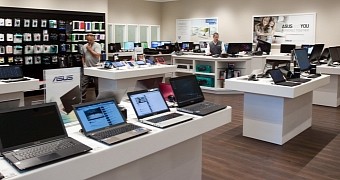This year’s shipments are the lowest in the last two years, according to Gartner, as the PC shipments totaled 68.4 million units in the second quarter of 2015, being 9.5% lower than 2014’s second quarter results.
According to analysts, the current PC shipments situation is caused by the current technology stagnation, caused probably by the impending major changes that will arrive at the end of 2015. As the new Intel Skylake is anxiously awaited across the world to make its appearance in August, old chipsets and CPU will simply not sell in the same numbers as they did the previous years.
The same analysts confirm this trend, expecting for PC shipments to grow back slowly as 2016 unfolds. However, other analysts at Gartner cited by DigiTimes consider that it has to do with the price spike of PC components due to sharp appreciation of the US dollar compared to the local industry. Also with the end of the Windows XP support, China had to invest in buying newer Windows licenses, also growing the number of new PCs bought.
Dwindling sales are the calm before the storm
All the top PC manufacturers in the world like Lenovo, Dell and HP felt considerable losses especially in Latin America and Japan, while in the US PC shipments totaled barely 15.1 million units in the second quarter of 2015, a lower units number than in 2014 by 5.8%. Apparently, these are the worst PC shipments numbers since the 2009 economic crisis. Although shipments numbers are generally to be expected to fall or stagnate before a major PC-oriented launch as Microsoft’s Windows 10, such low selling numbers are nothing short of worrying.
It’s considered that with the advent of the new operating system from Microsoft, sellers and worldwide retailers are self-regulating their inventory control to make room for the new OS. However, the most intriguing fact remains that while desktop PCs sales are falling, mobile PCs are registering a modest but steady sales growth as affordable notebooks are attracting more buyers than before, while stick-based miniPCs also attract through their low prices and extreme mobility.
Asia Pacific and Europe sales were better
In Europe and Middle-East, however, PCs sold better than they did in US, 18.6 million units in the second quarter of 2015, but also had a steeper sales drop of 15.7% compared to 2014. This higher sales number is thought to be caused by more effective marketing methods of clearing stocks for Windows 10; yet, it also shows the large buying potential lost compared to last year.
Finally, Asia-Pacific had the highest sales number, as was to be expected, with about 24.2 million units in the second quarter of 2015, and with a marginal 2.9% decline compared to 2014.
Shipment numbers are expected to grow significantly both for hardware components and software as the turn of the year will breathe new air into the PC industry as Intel and Windows work seemingly in tandem to bring new, exponentially more powerful offers on a market stagnating for almost two years.

 14 DAY TRIAL //
14 DAY TRIAL //